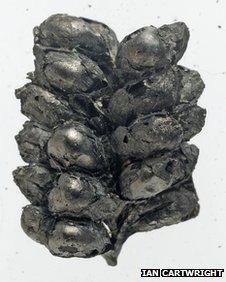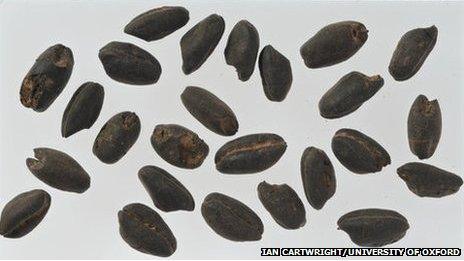Neolithic farmers used manure on crops
- Published

Neolithic farmers are thought to have invested in plots of land
Europe's first farmers used livestock manure on their crops 8,000 years ago, new research has found.
Neolithic samples from charred crop remains contained the type of nitrogen also abundant in manure.
This suggests farmers took a longer-term approach to cultivating their land, rather than leading a nomadic lifestyle.
The study, published in PNAS, external, could also shed new light on what early farmers ate.
The introduction of farming was one of the most important cultural shifts in history. This age of agriculture defines the Neolithic period, also known as the New Stone Age.
Until now, it was believed that using manure to fertilise crops was not developed until the Iron Age, the period before the Romans invaded Britain in AD43.

Charred remains were preserved in Neolithic houses destroyed by fire
Neolithic farmers were previously believed to maintain a nomadic lifestyle, perhaps a relic from hunter-gatherer days.
But now researchers suggest they invested in plots of land and cultivated it for future generations.
'Fixed investments'
Manuring crops involves a long-term investment in arable land. As dung breaks down slowly, crops benefit from its nutrients over many years.
A team led by Amy Bogaard from the University of Oxford found the stable isotope nitrogen-15 (N15), which is abundant in manure, in the charred cereal grains and pulses from 13 Neolithic sites across Europe.
"These results point to a different kind of farming where they were making fixed investments in land that they intended to hang onto and pass onto future generations," Dr Bogaard told BBC News.
This shift also had a radical social effect, as different families would have claimed plots of land and sought to hold onto those plots, she added.
"The idea that farmland could be cared for by the same family for generations seems quite an advanced notion, but rich fertile land would have been viewed as extremely valuable for the growing of crops.
"We believe that as land was viewed as a commodity to be inherited, social differences in early European farming communities started to emerge between the haves and the have-nots."

Scientists analysed charred crop remains such as wheat
The study may also alter the view of what Stone Age farmers ate. As manure is rich in N15, the crops fertilised with manure, and those who ate the crops, also had high N15 enrichment, explained Dr Bogaard.
Previously it was thought human fossil remains from this time had high values of N15 due to a diet rich in meat. The researchers now suggest that previous studies may have wrongly inferred that Neolithic farmers had a meat-rich diet.
Juan Pedro Ferrio from the University de Lleida, Spain, said: "There are other possible environmental factors, such as high temperature and rain, which could increase N15."
But he added that manuring - whether accidentally or on purpose - was a likely explanation, and that it was clear Neolithic farmers were eating grain more enriched with N15 compared to the values of leaves of the same plant.
- Published23 April 2013
- Published27 April 2012
- Published24 August 2011
- Published10 November 2010